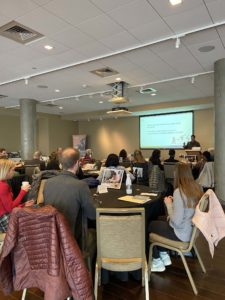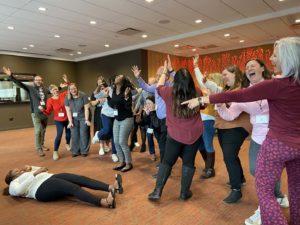By Jill Armington, CareerWise director of national partnerships
I’ve heard a lot of people say “this work moves at the speed of trust.” I’ve also heard a lot of people say “vulnerability builds connection and trust.” All three—vulnerability, connection, and trust—were present during the recent CareerWise Network retreat.
 There is infinite value in coming together to connect, swap learnings, and inspire new ideas. For many of us, it was the first time meeting our peers and colleagues from across the network. Things were off to a great start! Innovation share-outs, deep conversation about the design parameters, and a new bag of mindfulness tricks to wield against the stressors of our day-to-day work (hint: gratitude is a superpower, and two minutes of “box-breathing” can transform the other 1,438 minutes of your day.).
There is infinite value in coming together to connect, swap learnings, and inspire new ideas. For many of us, it was the first time meeting our peers and colleagues from across the network. Things were off to a great start! Innovation share-outs, deep conversation about the design parameters, and a new bag of mindfulness tricks to wield against the stressors of our day-to-day work (hint: gratitude is a superpower, and two minutes of “box-breathing” can transform the other 1,438 minutes of your day.).
But then things took a turn. Just after Drayton Boylston, Executive Mindfulness Coach finished encouraging each of us to practice saying “No” more often…the retreat agenda said we were off to…an Improv Class?!
I’m sure I wasn’t the only one thinking, “Um, could I practice saying no to this?”
Yet off we went to the Denver Center for the Performing Arts (DCPA) and spent the afternoon throwing ourselves out of our comfort zones. The experiences that came next made something clear for me: this national youth apprenticeship movement is a lot like improv. And no, it’s not because we’re all just making it up as we go along(!).
From the (slightly uncomfortable) improv exercises we did, we can draw many parallels with the work we do. I outline four lessons below.
For our work, I’ll sum it up this way: as intermediaries, as leaders, we must know when to say no and when to say yes. Sometimes perspectives may conflict with one another, challenging us—the intermediaries—to mediate and figure out the next best step forward amidst the paradoxes that abound around us.
 raising questions and pointing out obstacles.” While we know part of our work requires us to reflect on what’s not working, the key message here is to not remain in that space. Move from the problem to a solution. In our improv class, we did a “statue” activity where we each had to join a human-created freeze-frame already in progress. We added what we saw to make the statue more complete instead of changing what came before us. Whether sharing extensive feedback on programmatic design parameters, or performing a story told one sentence at a time alongside twenty colleagues, we asked questions about what is possible and moved forward.
raising questions and pointing out obstacles.” While we know part of our work requires us to reflect on what’s not working, the key message here is to not remain in that space. Move from the problem to a solution. In our improv class, we did a “statue” activity where we each had to join a human-created freeze-frame already in progress. We added what we saw to make the statue more complete instead of changing what came before us. Whether sharing extensive feedback on programmatic design parameters, or performing a story told one sentence at a time alongside twenty colleagues, we asked questions about what is possible and moved forward.
So what?
The work we do to propel the American youth apprenticeship movement forward is collaborative—no one of us can create a cohesive scene without listening and reacting to each other. At the same time, this work is full of contradictions (say “no” to more/say “yes, and…”): while we must define strategies that make the most impact with our limited resources, we benefit by exploring new innovations and strategies from our peers.
Maybe the biggest takeaway from the improv class was the recognition that although our work may be unique, the way we must collaborate with and learn from one another isn’t. We will continue to strengthen our community—a community built upon vulnerability, connection, and trust. It is through this intentional community that the CareerWise Network and the broader American youth apprenticeship movement will advance.
And, scene!